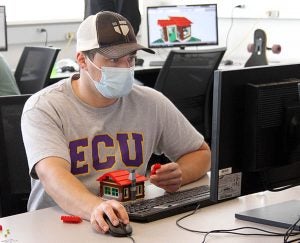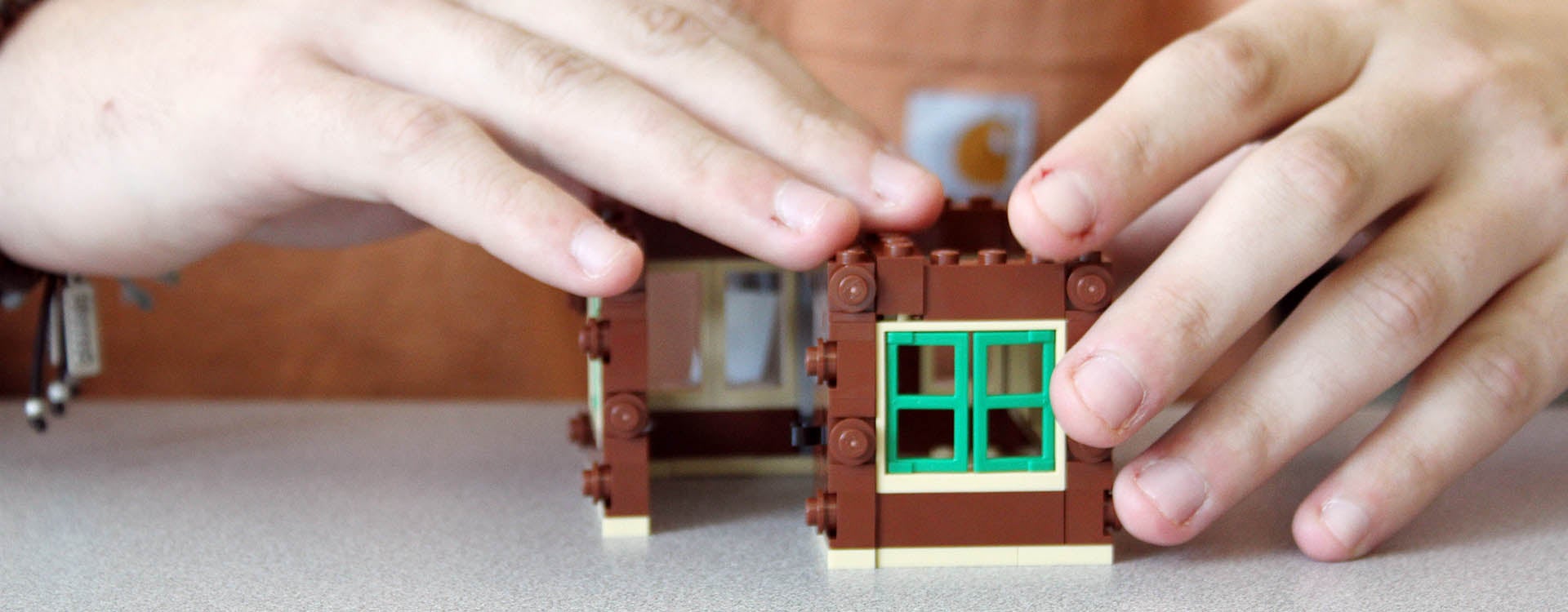Legos provide educational fun for ECU construction management students
Construction management students at East Carolina University graduate with skills that help them build structures that can be worth hundreds of thousands of dollars.

Dr. Yilei Huang, top, helps students in his construction management computer modeling class. (Photos by Ken Buday)
In Dr. Yilei Huang’s building information modeling (BIM) course, learning those skills starts with a set of Legos.
Thanks to a $5,000 course innovation grant from ECU’s Office for Faculty Excellence, Huang introduced a hands-on activity to students to enhance their learning.
“Being primarily a computer modeling course, it does not provide much physical, hands-on experience in the classroom as many other construction management courses do, so students mostly work individually on their computers,” said Huang, who is in his first semester teaching at ECU. “This activity mitigates that by getting students together to build something fun yet closely related to the course subject.”
As part of the work, four-member teams had to build a house out of Legos by following a 3D model from the Autodesk Navisworks Manage software. Students had to follow the design to create the foundation and then put together the walls, windows, doors, a chimney and roof in the proper order and location on the foundation. Huang played the roles of the homeowner’s agent and building inspector, making sure each team’s house met the design specifications.
He said the activity has three main benefits.
“The first part is team building,” he said. “Most students will work with their own group members, and they are going to do the same for other tasks during the semester, so it is a good opportunity to get to know each other, start some conversation and see everyone’s work style.
“The second part is to transfer theoretical knowledge to applications. When introducing the project information, the knowledge covered in previous classes is frequently referenced to establish the connection between theories and practices.
“The third part is to introduce the software. It is not the main software for the course but will be used again later. Students will have some knowledge and familiarity with the program after this activity, which will help in more complex tasks later in the course.”

East Carolina University student Kody Cyr works looks at design plans on a computer as he completes the roof during a construction management class.
Each person in the four-member team had a specific task as a subcontractor. For junior Kody Cyr of Clayton, he tackled the roof.
“Finding the orientation of the roof was a little difficult because some of the pieces ranged from four points to two points or a single,” he said. “The only part I messed up a little bit was when I was trying to do it without referencing the BIM model, and I didn’t overhang the roof on the first try, so I had to take it off and slide it over so everything would be enclosed.”
He said the activity allowed him to learn the software and have something to show for his work.
“I actually enjoyed this a lot,” he said. “It’s definitely a good introduction to the applications and procedures.”
Huang said role-playing was an important part of the activity because that’s what happens with real construction projects.
“Construction is all about teamwork, so it is important to know which party does what tasks in every project, including this activity,” he said. “Students play different subcontractors who receive material deliveries in class, and the instructor plays the construction manager, an agent or consultant to the owner, to specify the requirements and protocols. All these roles take their own responsibilities to ensure the timely completion of a project, and this activity does it just the same way.”
Huang also said the activity was timed at the beginning of the semester so it would be a foundation for work later in the course.
“The Lego house is specially selected so that its design components match very well with an actual house, so it helps students understand building structures and systems,” he said. “The course will continue with Autodesk Revit to create real building models instead of digital Lego models, but all the skills in navigating the model will be the same. Navisworks Manage will be used again later in the course for more complex tasks, so their knowledge and familiarity are already established.”
And it gives students a little fun in class.
“A course will contain a lot of materials, and these hands-on experiences are what students will always remember and talk about,” Huang said. “A good hands-on activity will connect several topics of the course together, require students to actively learn during the session and produce a final product out of all their efforts. Learning is a long and sometimes boring process, so it is important to blend something more interactive, engaging and fun at times.”

A student assembles a Lego house in Dr. Yilei Huang’s construction management computer modeling class.